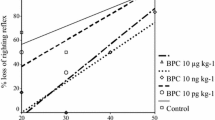Abstract
Some of the effects of bacterial toxins are mediated through the local production of nitric oxide (NO) or its products. This study examined if NO inhibition in the intestinal mucosa had effects on the responses to intravenous lipopolysaccharide (LPS) in anesthetized rats. Aminoguanidine (AMGU, 500 μM), a relatively selective inducible NO synthase (iNOS) inhibitor, or N G-nitro-l-arginine (NOLARG, 50 or 500 μM), a nonselective inhibitor of iNOS and constitutive NOS (cNOS), were perfused through the ileal lumen during intravenous LPS (17 mg/kg) or saline administration. Intestinal H2O transport, NO3 − + NO2 − (NOx) secretion, absorptive site mucosal blood flow (ASBF), blood pressure, plasma [NOx], tissue damage, and blood leukocytes were measured for 4 hr. LPS increased luminal NOx secretion. At 50 μM, luminal NOLARG attenuated the LPS-induced NOx secretion and increased blood pressure. There were no significant changes in lethality, plasma [NOx] or other parameters. At 500 μM, luminal NOLARG converted a nonlethal dose of LPS into a lethal dose, but AMGU did not increase lethality. The LPS-induced luminal NOx secretion was blocked by 500 μM intraluminal AMGU and NOLARG. Luminal NOx secretion also increased in control animals. This increase was blocked by 500 μM NOLARG but not AMGU. Luminal 500 μM NOLARG increased blood pressure, but AMGU did not. Luminal 500 μM NOLARG prevented the LPS-induced increase in plasma [NOx] and the decrease in leukocytes, but AMGU did not. Tissue damage occurred with intravenous LPS plus intraluminal 500 μM NOLARG. It was concluded that luminal AMGU inhibited mucosal iNOS. Luminal NOLARG inhibited mucosal cNOS and iNOS, and cNOS inhibition primed a lethal LPS effect. NOLARG, but not AMGU, was absorbed from the intestine and had systemic effects.
Similar content being viewed by others
REFERENCES
Glauser MP, Zanetti G, Baumgartner JD, Cohen J: Septic shock: pathogenesis. Lancet 338:732–736, 1991
Szabo C, Thiemermann C: Invited opinion: Role of nitric oxide in hemorrhagic, traumatic, and anaphylactic shock and thermal injury. Shock 2:145–155, 1994
Furfine ES, Harmon MF, Paith JE, Garvey EP: Selective inhibition of constitutive nitric oxide synthase by L-N(G)-nitroarginine. Biochemistry 32:8512–8517, 1993
Moore E, Moore F, Franciose R, Kim F, Biffl W, Banerjee A: The postischemic gut serves as a priming bed for circulating neutrophils that provoke multiple organ failure. J Trauma 37:881–887, 1994
Gaboury J, Johnston B, Niu X, Kubes P: Mechanisms underlying acute mast cell-induced leukocyte rolling and adhesion in vivo. J Immunol 154:804–813, 1995
Nathan C, Xie Q: Regulation of the biosynthesis of nitric oxide. J Biol Chem 269:13725–13728, 1994
Arya R, Grossie VB, Weisbrodt NW, Lai M, Mailman D, Moody F: Temporal expression of tumor necrosis factor-(alpha) and nitric oxide synthase 2 in the rat small intestine after endotoxin. Dig Dis Sci 45:744–749, 2000
Zembowicz MJ, Zembowicz A, Khan AR, Higham SC, Weisbrodt NW, Moody FG, Pressley TA, Lodato RF: Characterization of calcium-independent NO synthase expressed in the ileum of healthy rats. In The Biology of Nitric Oxide, S Moncada, J Stamler, S Gross, EA Higgs (eds). London, Portland Press, 1996, pp 296–301
Hoffman RA, Zhang G, Nussler NC, Gleixner SL, Ford HR, Simmons RL, Watkins SC: Constitutive expression of inducible nitric oxide synthase in the mouse ileal mucosa. Am J Physiol 272:G383–G392, 1997
Lopez-Belmonte J, Whittle BJR, Moncada S: The actions of nitric oxide donors in the prevention or induction of injury to the rat gastric mucosa. Br J Pharmacol 108:73–78, 1993
Laszlo F, Whittle BJR, Moncada S: Time-dependent enhancement or inhibition of endotoxin-induced vascular injury in rat intestine by nitric oxide synthase inhibitors. Br J Pharmacol 111:1309–1315, 1994
Salzman A: Nitric oxide in the gut. New Horiz 3:352–364, 1995
Billiar TR, Harbrecht BG: Resolving the nitric oxide paradox in acute tissue damage. Gastroenterology 113:1405–1407, 1997
Corbett JA, Tilton RG, Chang K, Hasan KS, Ido Y, Wang JL, Sweetland MA, Lancaster JR, Williamson JR, McDaniel ML: Aminoguanidine, a novel inhibitor of nitric oxide formation, prevents diabetic vascular dysfunction. Diabetes 41:1629–1632, 1992
Griffiths MJD, Messent M, Macallister RJ, Evans TW: Aminoguanidine selectively inhibits inducible nitric oxide synthase. Br J Pharmacol 110:963–968, 1993
Mailman D, Self A, Henry M: Time and surgery-dependent effects of lipopolysaccharide on gut, cardiovascular and nitric oxide functions. Shock 12:208–214, 1999
Wennmalm A, Benthin G, Petersson AS: Dependence of the metabolism of nitric oxide (NO) in healthy human whole blood on the oxygenation of its red cell haemoglobin. Br J Pharmacol 106:507–508, 1992
Granger DL, Taintor RR, Boockvar KS, Hibbs JB: Determination of nitrate and nitrite in biological samples using bacterial nitrate reductase coupled with the Griess reaction. Methods 7:78–83, 1995
Mailman D: Differential effects of lumenal L-arginine and N G-nitro L-arginine on blood flow and water fluxes in rat ileum. Br J Pharmacol 112:304–310, 1994
Boughton-Smith NK, Evans SM, Laszlo F, Whittle BJR, Moncada S: The induction of nitric oxide synthase and intestinal vascular permeability by endotoxin in the rat. Br J Pharmacol 110:1189–1195, 1993
Gottesfeld Z, Maier M, Mailman D, Lai M, Weisbrodt NW: Splenic sympathetic response to endotoxin is blunted in the fetal alcohol-exposed rat: Role of nitric oxide. Alcohol 16:19–24, 1998
MacFarlane AS, Schwacha MG, Eisenstein TK: In vivo blockage of nitric oxide with aminoguanidine inhibits immunosuppression induced by an attenuated strain of Salmonella typhimurium, potentiates Salmonella infection, and inhibits macrophage and polymorphonuclear leukocyte influx into the spleen. Infect Immun 67:891–898, 1999
Gryglewski RJ, Wolkow PP, Uracz W, Janowska E, Bartus JB, Balbatun O, Patton S, Brovkovych V, Malinski T: Protective role of pulmonary nitric oxide in the acute phase of endotoxemia in rats. Circ Res 82:819–827, 1998
Moore FA, Moore EE: Evolving concepts in the pathogenesis of postinjury multiple organ failure. Surg Clin North Am 75:257–277, 1995
Niu XF, Ibbotson G, Kubes P: A balance between nitric oxide and oxidants regulates mast cell-dependent neutrophilendothelial cell interactions. Circ Res 79:992–999, 1996
Author information
Authors and Affiliations
Rights and permissions
About this article
Cite this article
Mailman, D. Ileal Luminal Nitric Oxide Synthase Inhibitors and E. coli Lipopolysaccharide Effects in the Anesthetized Rat. Dig Dis Sci 47, 190–200 (2002). https://doi.org/10.1023/A:1013200511853
Issue Date:
DOI: https://doi.org/10.1023/A:1013200511853




